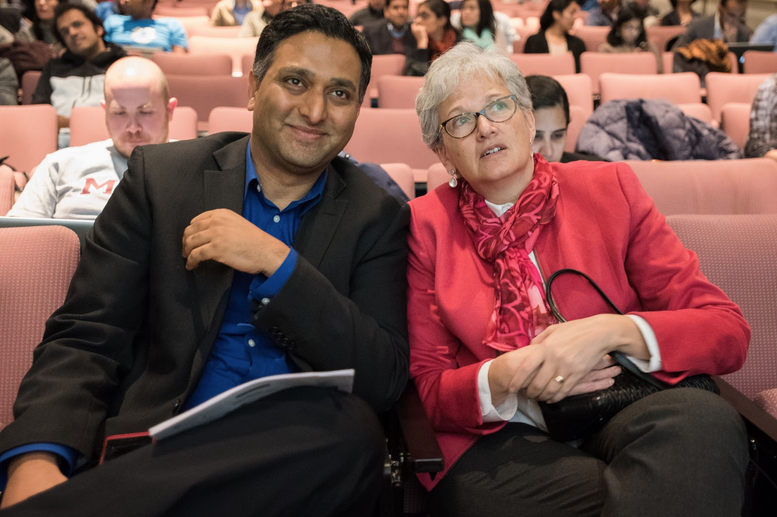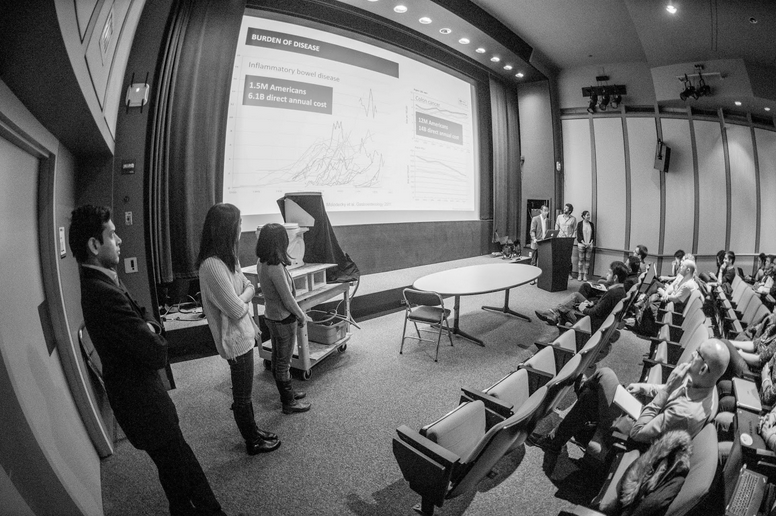Global health is a challenge of scale. Oftentimes we wonder who takes on these types of problems, and the amorphous THEY have traditionally accepted the burden of responsibility. Is there a gigantic effort to systematically solve global healthcare? Who are THEY?
The unfortunate truth is that comprehensive and innovative approaches to addressing the complex global health landscape just don’t exist, but Ramesh Raskar’s group at the MIT Media Lab is looking to change that. In September, students from a diverse set of departments at MIT met at the “Engineering Health” class to discuss with doctors and clinical practitioners about what kind of challenges they face on a daily basis. Over the next three months, students worked with technical and clinical mentors to demonstrate the incredible transition from physician’s dream to working prototype.
To wrap up the semester, Doctors, Entrepreneurs, and Engineers all gathered to watch the MIT students present their solutions in the historic Bartos theatre at the MIT Media Lab. Designs were not merely constructed to impress the audience, they were deployment centric from the outset, and many groups stated their desire to continue working on their project. A pipeline is in place and we watched that vision come to fruition. In a parallel effort with Ramesh’s group, some students will travel to Mumbai at the end of January to further refine their designs.
The teams seemed to challenge the audience: What if doctors could spend less time being being medical device technicians and more time treating patients? The teams think that would change medicine for the better.
Meet the innovators.
MDSpec
Detecting skin cancer on a large scale.
Reducing the number of unnecessary biopsies would lower costs, hasten diagnosis, and enable more routine evaluation, especially in resource constrained communities. MDSpec uses a mobile phone’s processor to evaluate a signal known to indicate the presence of cancerous tissue, allowing instant feedback about the status of potentially cancerous skin lesions.
Athena Breast Pump
Women don’t use breast pumps when they should.
Breast pumps are not smart devices. The Athena breast pump’s goal is to eliminate discomfort using technology, allowing mothers to deliver the best possible nutrition for their infants.
Smart Toilet
We are missing out on a wealth of invaluable health data.
Health on the scale of cities. If there was a way to seamlessly access potential biological data without weirding us out, society stands to benefit greatly. Viruses could be tracked in real time, and cancers could be detected earlier than ever before. Smart Toilet solves the interface problem, inconspicuously bringing the lab into the home.
EarID
Ear infection identification without waiting in line at the clinic.
A new type of eardrum imaging that uses clever illumination methods to create 3D models of the eardrum to identify ear infections and other ear problems.
ICUCam
Monitoring the stress of patients in the ICU 24/7.
Using a simple modification to existing web cameras, we can monitoring vital signs from a video feed automatically, ensuring the safety of patients in the ICU. Monitor stress levels and alert the nurse if a patient needs attention.
Anterior Segment Ocular Imaging
Comprehensive eye exams are too expensive.
Replacing mechanical complexity with solid state innovation, the ASOI uses a type of projection technology to produce patterns on the front of the eye useful for diagnosis of an entire class of eye conditions.
Debubbler
Bubbles are hard to remove in automatic injection systems.
Ever see your doctor flick bubbles from the side of a syringe before injection? Those bubbles are dangerous! The Debubbler is an automatic way to remove bubbles even a manual flick has trouble dislodging. Perfect for automated injection devices, and people untrained in the art of the flick.
ASCUL
Comprehensive, modern solution for listening to the chest.
Medicine has changed in major ways in the last hundred years, but the staple tool – the stethoscope – has hardly changed at all. ASCUL is a stethoscope array, it uses many stethoscopes together to record the signals from your chest and provide a sonic map of breathing patterns and heartbeats. ASCUL could allow untrained users to obtain a diagnosis only a doctor could provide previously.
Learn More: https://www.facebook.com/tricorder2013
The Class: http://cameraculture.media.mit.edu/enghealth/
Stay in Touch: https://adobeformscentral.com/?f=zBS9JdTsHxnmdp-twb1hmA





